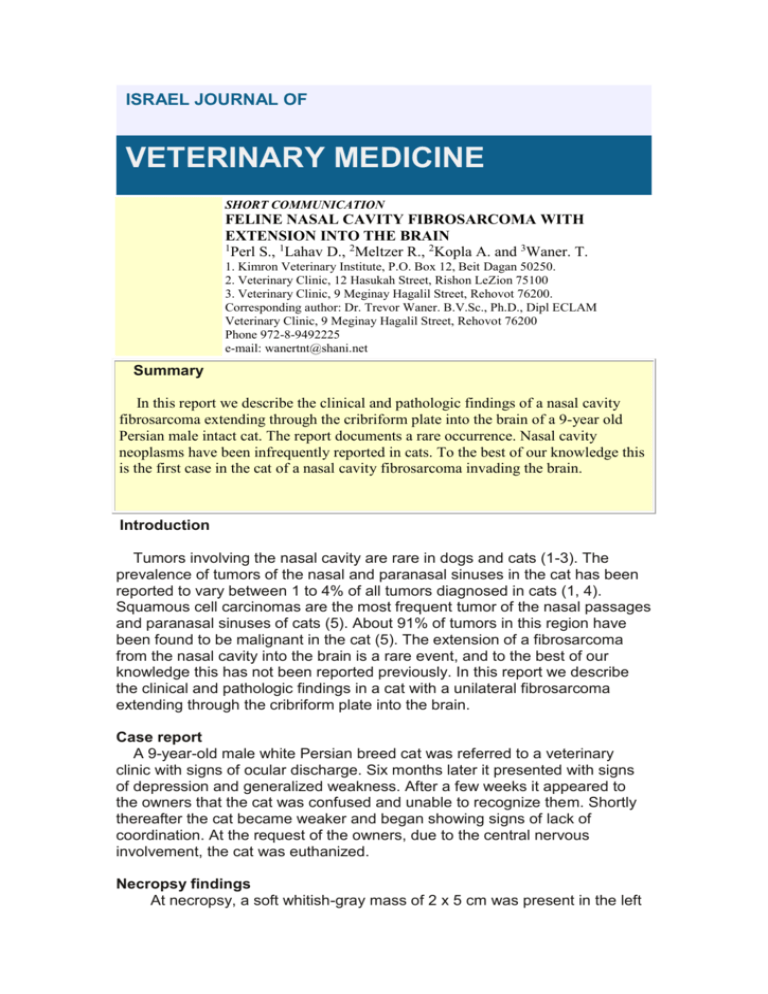feline nasal cavity fibrosarcoma with extension into the brain
advertisement

ISRAEL JOURNAL OF VETERINARY MEDICINE SHORT COMMUNICATION FELINE NASAL CAVITY FIBROSARCOMA WITH EXTENSION INTO THE BRAIN 1 Perl S., 1Lahav D., 2Meltzer R., 2Kopla A. and 3Waner. T. Vol. 60 3) 2005 1. Kimron Veterinary Institute, P.O. Box 12, Beit Dagan 50250. 2. Veterinary Clinic, 12 Hasukah Street, Rishon LeZion 75100 3. Veterinary Clinic, 9 Meginay Hagalil Street, Rehovot 76200. Corresponding author: Dr. Trevor Waner. B.V.Sc., Ph.D., Dipl ECLAM Veterinary Clinic, 9 Meginay Hagalil Street, Rehovot 76200 Phone 972-8-9492225 e-mail: wanertnt@shani.net Summary In this report we describe the clinical and pathologic findings of a nasal cavity fibrosarcoma extending through the cribriform plate into the brain of a 9-year old Persian male intact cat. The report documents a rare occurrence. Nasal cavity neoplasms have been infrequently reported in cats. To the best of our knowledge this is the first case in the cat of a nasal cavity fibrosarcoma invading the brain. Introduction Tumors involving the nasal cavity are rare in dogs and cats (1-3). The prevalence of tumors of the nasal and paranasal sinuses in the cat has been reported to vary between 1 to 4% of all tumors diagnosed in cats (1, 4). Squamous cell carcinomas are the most frequent tumor of the nasal passages and paranasal sinuses of cats (5). About 91% of tumors in this region have been found to be malignant in the cat (5). The extension of a fibrosarcoma from the nasal cavity into the brain is a rare event, and to the best of our knowledge this has not been reported previously. In this report we describe the clinical and pathologic findings in a cat with a unilateral fibrosarcoma extending through the cribriform plate into the brain. Case report A 9-year-old male white Persian breed cat was referred to a veterinary clinic with signs of ocular discharge. Six months later it presented with signs of depression and generalized weakness. After a few weeks it appeared to the owners that the cat was confused and unable to recognize them. Shortly thereafter the cat became weaker and began showing signs of lack of coordination. At the request of the owners, due to the central nervous involvement, the cat was euthanized. Necropsy findings At necropsy, a soft whitish-gray mass of 2 x 5 cm was present in the left nasal cavity. The tumor mass had destroyed the turbinate bones and eroded through the lamina cribosa of the ethmoid bone and penetrated the brain in the region of the frontal and the left olfactory lobes. No lesions were detected in the regional lymph nodes. No other pathological findings were present in any other internal organ. Histopathological findings The normal architecture of the nasal cavity was completely replaced by compact neoplastic tissue. The tumor mass was poorly delineated, highly cellular and composed of interlacing streams and whorls of spindle shaped cells. The neoplastic cells had indistinct boarders with a moderate amount of eosinophilic fibrillar cytoplasm. The nuclei were round to oval with lightly stippled chromatin, prominent nuclear borders, and a single, usually centrally located nucleolus. Mitoses averaged about 1-2 per high power field. Multifocally within the mass there were areas of necrosis, hemorrhage and infiltrates of lymphocytes. Within the nasal cavity the neoplastic cells had replaced bone matrix of the turbinates (Fig. 1). In the brain, the tumor extended into the neuropil of the frontal lobe in a number of foci (Fig. 2). Adjacent to the invasive tumor there were hemorrhages with vacuolation and necrosis of the neuropil. A number of multinucleated giant cells was evident, along with Gitter cells, some containing hemosiderin. Figure 1. Nasal cavity. A highly cellular mass composed of interlacing streams and whorls of spindle shaped cells, invading and replacing bone matrix of the turbinates, and infiltrating into the submucosa underlying the respiratory epithelium. Figure 2. Fibrosarcoma originating in the nasal cavity of a into the neuropil of the frontal lobe. Necrosis of t presence of multinucleated giant cells are eviden cells. Discussion A specific diagnosis was not made based on clinical signs. Classical clinical signs include sneezing, nasal or ocular discharge, which may be bloody and dyspnea (4). With the exception of an ocular discharge, there was no indication of nasal cavity neoplasia. Neurological signs of neoplasia were apparent at a late stage of the disease, but were not specific for nasal cavity neoplasia with extension to the brain. The signalment for a cat with nasal or paranasal cavity neoplasia includes male castrated cats older than 6 years of age (4). In this regard it is interesting to note that the cat is the only species in which a sex difference in the occurrence of nasal neoplasms has been found, with males nearly twice as likely to have nasal neoplasms than females (5). Furthermore data indicates that castrated male cats are at greatest risk (4). The cat presented in this case was a 9-year old intact male. There is inadequate information in the literature regarding the incidence of the tumors in different breeds of cats, although a number of cases have been reported in the Persian breed (4). In a review of 35 cases of naturally occurring microscopically confirmed tumors of the nasal cavity and paranasal sinuses of cats, only one was reported as a fibrosarcoma (5). In another survey, 16 cases with nasal/paranasal tumors were presented and only one case was diagnosed as a fibrosarcoma which did not invade the brain of a 9-year-old male castrated cat (4). Overall, of the 16 cases reported two were carcinomas, both of which invaded the brain. From the literature it appears that besides the scarcity of this tumor in the nasal cavity of cats, its invasion into the brain is even more uncommon although the majority of nasal tumors are located near the cribriform plate (1). At necropsy, the tumor was found to be located unilaterally. Although no data are available for cats, approximately half of tumors in the dog invade the contralateral nasal cavity at the time of diagnosis (6). In summary, this report documents a rare occurrence of a fibrosarcoma of the nasal cavity of a cat with extension into the brain. Nasal cavity neoplasms have been infrequently reported in cats with only two instances of fibrosarcomas documented in the literature. To the best of our knowledge this is the first case in the cat of a nasal cavity fibrosarcoma invading the brain. LINKS TO OTHER ARTICLES IN THIS ISSUE References 1. Ogilvie, G.R. and LaRue, S.M. Canine and feline nasal and paranasal tumors. Vet. Clinics of North America. Small Animal Pract. 22:1133-1143, 1992. 2. Nyska, A., Klopfer, U., Perl S., Nobel, T.A. and Bark, H. Tumors in the nasal cavity of dogs — five case reports. Isr. J. Vet. Med. 37:145-150, 1980. 3. Legendre, A.M., Carrig, C.B., Howard, D.R. and Dade, A.W. Nasal tumor in a cat. JAVMA. 167:481-483, 1975. 4. Cox, N.R., Brawner, W.R., Powers, R.D. and Wright, J.C. Tumors of the nose and paranasal sinuses in cats: 32 cases with comparison to a national database (1977 through 1987). JAAHA. 27:339-347, 1991. 5. Madewell, B.R., Priester, W.A., Gillette, E.L. and Synder, S.P. Neoplasms of the nasal passages and paranasal sinuses in domesticated animals as reported by 13 veterinary colleges. Am. J. Vet. Res. 37: 851-856, 1976. 6. Patnaik, A.K.(1989) Canine sinonasal neoplasms: Clinicopathological study of 285 cases. JAAHA. 25: 103-114, 1989. 1.






